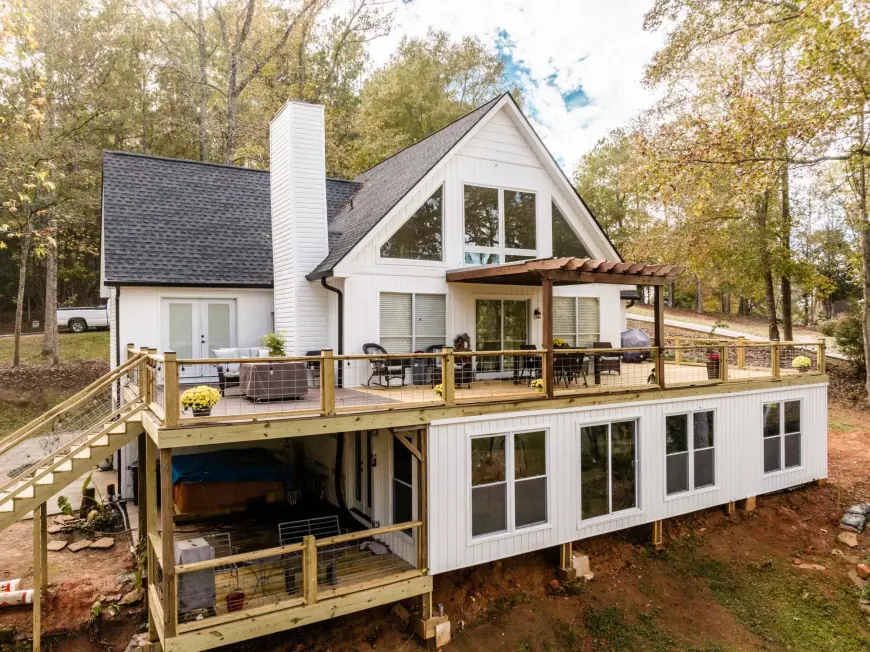How to Build a Deck: Design Ideas & Materials to Choose

Building a deck is a fantastic way to enhance the functionality and appeal of your outdoor space. Whether you're looking for a peaceful retreat to unwind or a place to entertain guests, the right combination of design and materials can transform your backyard into an inviting oasis. When you decide to build a deck, one of the first decisions you'll need to make is choosing the perfect design and materials. These two elements will influence the deck’s longevity, maintenance requirements, and overall aesthetic. In this article, we’ll explore various design ideas, materials, and helpful tips to guide you in creating a deck that fits your style and needs.
Introduction: How Design and Materials Affect Your Deck’s Look and Feel
The design of your deck is crucial because it determines not only how the deck functions but also how it will look against your home’s architecture and your yard’s landscape. Whether your vision is classic or contemporary, your design should complement the surrounding space.
When you choose materials for your deck, you must consider both their functionality and aesthetic appeal. Materials like pressure-treated wood, composite decking, and PVC offer different levels of durability, maintenance needs, and environmental impact. The combination of the right design and materials will ensure that you build a deck that suits your lifestyle and enhances your property’s value.
Design Idea 1: Classic Wooden Deck
A classic wooden deck is an enduring choice for many homeowners. Wood naturally complements both traditional and modern outdoor spaces, giving a warm, inviting feel to your yard. If you want to build a deck with timeless appeal, a wooden deck is an excellent option.
Why Choose a Classic Wooden Deck?
- Aesthetic Appeal: Wood brings a rich, natural beauty to your outdoor space. Whether you choose cedar, redwood, or pressure-treated pine, each type of wood has its unique characteristics, such as color variations and grain patterns, that can enhance the look of your deck.
- Versatility: A wooden deck can be designed in many different styles, from a simple rectangular shape to a more complex multi-level structure. You can add custom features like built-in benches, railings, or planters for added functionality and style.
- Customization: Wood allows you to personalize the deck more easily compared to other materials. You can stain, seal, or paint the wood in any color to achieve the desired aesthetic for your deck.
However, it’s important to note that wooden decks require more maintenance than other materials. Regular sealing and staining are necessary to protect the wood from moisture, UV damage, and decay.
Design Idea 2: Modern Composite Deck
For those who want to build a deck with low maintenance and long-lasting durability, a composite deck may be the right choice. Composite decking is made from a combination of wood fibers and plastic, which results in a product that is both durable and resistant to wear and tear.
Why Choose a Modern Composite Deck?
- Durability: Composite decking resists fading, staining, rotting, and insect damage, making it ideal for areas with harsh weather conditions or high foot traffic.
- Low Maintenance: Unlike wooden decks, composite decks do not need to be sanded, stained, or sealed. This makes them a convenient option for homeowners who want a beautiful deck without the hassle of ongoing upkeep.
- Variety of Colors and Styles: Composite decks are available in various colors and textures, so you can select a style that fits your vision. Whether you want a clean, contemporary look or something that mimics the appearance of natural wood, composite decking offers plenty of options.
While composite decking can be more expensive upfront than wood, its low maintenance requirements make it a cost-effective choice in the long run.
Material Tip 1: Pros and Cons of Pressure-Treated Wood
When you decide to build a deck, one of the most common materials people choose is pressure-treated wood. This wood has been chemically treated to resist moisture, insects, and decay, making it an affordable and durable option for decking.
Pros of Pressure-Treated Wood:
- Cost-Effective: Pressure-treated wood is one of the most budget-friendly decking materials available, which makes it a popular choice for those looking to build a deck on a budget.
- Durable: The treatment process helps the wood resist the damaging effects of moisture, insects, and fungi.
- Widely Available: You can find pressure-treated wood at most home improvement stores, making it a convenient option for DIY deck builders.
Cons of Pressure-Treated Wood:
- Ongoing Maintenance: Over time, pressure-treated wood may warp, crack, or fade. To maintain its appearance and durability, you’ll need to stain, seal, and regularly inspect the deck.
- Environmental Concerns: The chemicals used in the pressure treatment process can be harmful to the environment. If eco-friendliness is a priority for you, you may want to explore alternative materials.
Pressure-treated wood remains a popular and affordable option for many, but the need for regular care and maintenance is an important consideration when you build a deck.
Material Tip 2: Composite and PVC Decking for Durability
For homeowners who prioritize durability and low maintenance, composite and PVC decking are top choices. Both materials offer superior resistance to weathering, rot, and fading, which makes them ideal for building a deck that lasts for years.
Composite Decking:
- Low Maintenance: Composite decks require minimal upkeep compared to wood, and they do not splinter or crack over time.
- Sustainable Option: Many composite materials are made from recycled wood and plastics, making them an eco-friendly choice.
- Variety of Designs: Composite decks come in a wide range of colors, textures, and styles, allowing you to create the perfect look for your outdoor space.
PVC Decking:
- Water and Mold Resistant: PVC decking is made entirely from plastic, which makes it highly resistant to mold, mildew, and moisture.
- Easy to Clean: PVC decking is non-porous, so it is easier to clean and maintain than wood or composite decking.
- Modern Look: PVC decking has a sleek, smooth finish that suits modern design preferences.
While composite and PVC decks typically have a higher initial cost than wood, their longevity and minimal upkeep make them a smart investment for many homeowners.
Material Tip 3: Sustainable and Eco-Friendly Decking Options
If you're passionate about sustainability and want to reduce your environmental impact when you build a deck, there are several eco-friendly decking options to consider.
Recycled Materials: Many composite and PVC decking products are made from recycled wood fibers, plastics, and other materials. These options help reduce waste and use less virgin plastic or wood.
Bamboo Decking: Bamboo is a fast-growing, renewable resource, making it an environmentally friendly alternative to traditional hardwoods. Bamboo decking is both durable and aesthetically pleasing, often providing a contemporary look with a hint of exotic flair.
Cedar and Redwood: These naturally durable woods are an eco-conscious choice, as they grow relatively quickly and have natural resistance to pests and decay. They can be a great option if you prefer a more traditional wood deck but still want to make an environmentally friendly choice.
Conclusion: Choosing the Right Combination of Design and Materials
When you decide to build a deck, understanding the impact of both design and materials is essential for creating a space that is functional, stylish, and long-lasting. Whether you choose a classic wooden deck or opt for a modern composite or PVC deck, each material has its benefits and considerations.
The key to successfully building a deck is selecting materials that align with your maintenance preferences, aesthetic goals, and budget. If you’re looking for an eco-friendly option, sustainable decking materials like bamboo or recycled composites may be a great choice. Whatever you decide, the right combination of design and materials will ensure that your new deck becomes a valuable addition to your home, offering years of enjoyment.

 jenniferalena3
jenniferalena3 










